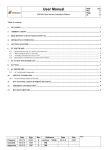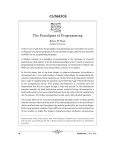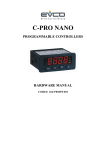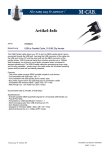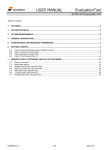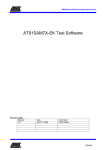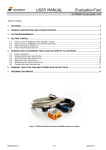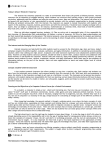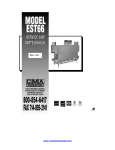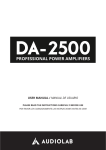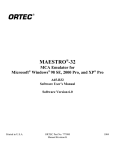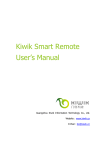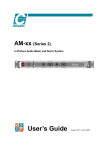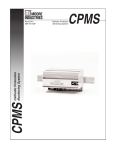Download User Manual SAR100 and SAR150 EVP
Transcript
USER MANUAL EvaluationTool SAR100 and SAR150 EVP Table of contents: 1 FEATURES ................................................................................................................................................................ 2 2 GENERAL DESCRIPTIONS AND SYSTEM CONTENTS ........................................................................................ 2 3 OPERATING CONDITIONS....................................................................................................................................... 3 4 GETTING STARTED .................................................................................................................................................. 3 5 PC SOFTWARE DESCRIPTIONS ............................................................................................................................. 4 5.1 5.2 5.3 5.4 DETAILED DESCRIPTIONS FOR MENUS, BUTTONS ETC. .............................................................................................. 5 EXAMPLE OF MEASUREMENT RESULT LOG FILE ........................................................................................................ 6 EXAMPLE OF SIMPLE INTEGRATED ANGLE TEST ........................................................................................................ 7 SEND SPECIAL COMMAND FOR RECOVERABLE ERROR HANDLING .............................................................................. 8 6 PC TO MAIN PCB INTERFACE DESCRIPTIONS .................................................................................................... 8 7 MAIN PCB DESCRIPTIONS ...................................................................................................................................... 9 8 MAIN PCB TO SATELLITE PCB WIRING DIAGRAM .............................................................................................. 9 9 SATELLITE PCB DESCRIPTIONS ........................................................................................................................... 9 10 10.1 MICRO CONTROLLER FIRMWARE DESCRIPTIONS ....................................................................................... 10 MICRO CONTROLLER TO GYRO SENSOR COMMANDS ........................................................................................... 10 11 SUMMARY TABLES FOR AVAILABLE EVPS AND RELATED TOOLS .......................................................... 11 12 REFERRED DOCUMENTS .................................................................................................................................. 11 DOK339 rev.1 1/11 March 2011 USER MANUAL EvaluationTool SAR100 and SAR150 EVP 1 Features 2 Up to 2000Hz sampling rate Data presentation and data log to file Available header pin rows for gyro sensor interface and signal access In-system programmable micro controller firmware (upgradable by USB) General descriptions and system contents The SAR100 and SAR150 evaluation platform (EVP) is an evaluation tool for rapid gyro sensor measurements in an office environment. Gyro sensor data is requested from PC software and results are presented on screen. Data log to file is supported and numerous gyro sensor signals are made available on header pin rows for evaluation and monitoring purposes. Add-on EVP satellite PCBs and interface cables for connections to the EVP main PCB are available. EVP main PCBs and EVP satellite PCBs are also available without any target gyro sensors pre-mounted. Source codes and hardware schematics are available. System contents: - EVP user manual (a printed version of this document) PC software USB cable EVP main PCB EVP satellite PCB (optional) Interface cable for EVP main to EVP satellite PCB connection (optional) Included CD-ROM (or memory stick) with EVP installation files and documentation Custom interface cable EVP satellite PCB EVP main PCB USB cable EVP PC software Figure 1: SAR100 and SAR150 EVP system setup schematics Micro controller USB mini-B connector EVP main PCB P1 header pin rows SAR100/SAR150 3.3V/5V level converter Figure 2: SAR100 and SAR150 EVP main PCB DOK339 rev.1 2/11 March 2011 USER MANUAL EvaluationTool SAR100 and SAR150 EVP 3 Operating conditions Table 1: EVP main PCB operating conditions Parameter Ambient temperature for EVP main PCB Specification Min Max Unit 10 30 °C Testing over temperature can be performed by connecting the EVP main PCB to a satellite PCB. See chapter 8 and 9 for more information. 4 Getting started PC software installation files and EVP documentation are included on a storage media (memory stick or CD-ROM) included in the package. The latest versions of files and documentation are also found at the Sensonor web site (www.sensonor.com). To get started using these tools follow the step-by-step instructions below. Step 1: Installation of PC software and EVP USB driver 1. Unzip and save the correct software installation file, e.g. the one for Win Xp operating system “PC Software SAR100 and SAR150 EVP vx.0.0 (Xp).zip”, to a local drive 2. Run the setup file (setup.exe) 3. A pop-up message during installation will ask for permission to install a USB driver (6119.inf) for the EVP. This is a driver which is not verified by Windows. Select nevertheless the choice “Install this driver software anyway”. The driver file does not represent a security threat Figure 3: USB driver installation (click ‘install this driver software anyway’) 4. Complete the installation process by following the on-screen instructions. When the installation is completed, click “Finish”. See Figure 4 and Figure 5. 5. Verify the USB driver successfully installed by connecting the EVP main EVP and finding the “AT91 USB to Serial Converter (COMx)" in the device manager (win Xp example). Notice at the same time the associated COM port number as this is needed for configuring the PC software correctly in the next step Figure 4: Installation in progress DOK339 rev.1 Figure 5: Installation complete 3/11 March 2011 USER MANUAL EvaluationTool SAR100 and SAR150 EVP Step 2: First PC software start-up 1. Keep the EVP main PCB connected to the PC via USB, or ensure to connect it again 2. Start PC software from PC start menu 3. The graphical user interface should appear on screen, and the EVP is now ready for use 5 PC Software descriptions The EVP PC software has been developed in LabWindows CVI. There are a few classical roll-down menues available. Distributed buttons and input boxes are set up to control gyro sensor measurements. Figure 6: PC software graphical user interface. (Showing 5s burst length, 50Hz sampling rate, angular rate measurement sequence for 250deg/s SAR150. With COM 3 in use) Description of first time usage of PC software: 1. Enter the correct COM port number for the EVP main PCB connection in the COM port input box and press the „Open COM port‟ button. (The correct COM port number is the one noticed from the device manager list, as already described in step 1 in Chapter 4). Verify that the green LED becomes visible (as seen on Figure 6). This indicates that the COM port has been successfully opened and that the connection to the EVP main PCB is established. 2. Prepare to measure with the gyro sensor by selecting the correct angular rate range of the product, the desired measurement type, sampling frequency and burst length, and possibly selecting „Save data to file‟ if a log file is this is required 3. Start a measurement series by pressing the „Measure‟ button DOK339 rev.1 4/11 March 2011 USER MANUAL EvaluationTool SAR100 and SAR150 EVP Measurement results are graphically presented on screen and written to a text file if the „Save data to file‟ box is checked. Real time data is shown for sampling frequecies up to 61Hz, while data is post-presented for sampling frequencies from 62 to 2000Hz. This was the quick start part of the manual in order to start measuring. For more details continue reading until the end of the document. 5.1 Detailed descriptions for menus, buttons etc. COM port input box and buttons. COM port input box: For selecting the assigned COMport number for the EVP main PCB Open COM port button: Opens the selected COM port. (Visible when the COM port is closed) Note: “Good practice” is to ensure to open the COM port as the first operation after start-up of software Close COM port button: Closes the selected COM port. (Visible when the COM port is open) Note: “Good practice”: is to ensure to close the COM port as the last operation before closing the software Connected/ Disconnected LED: This is a green LED which is visible when the selected COM port is open Upper row of slides and buttons. „Angular rate range‟ slide: To select the correct gyro sensor range, E.g. „250‟ or „100°/s‟ „Measurement type‟ slide: To select the chosen measurement type, „Angular rate‟ or „Temperature‟ „Sampling rate‟ slide: To select the sampling rate, „50‟, „100‟, or „500‟ Hz, or „Custom‟ to prepare to chose a custom sampling rate (see below). „Measure‟ button: To start measurements „Stop‟ button: To stop measurements. (Enabled when a measurement sequence is in progress) Lower row of check- and input boxes. „Save data to file‟: To save the measured data to a text file. (An active check box saves measured data to file.) „Burst length‟: To select a burst/sampling length (in seconds) „Custom sampling rate‟: To select a custom sampling rate in Hz. The box is enabled when „Custom‟ rate is chosen on the „Sampling rate‟ ring slide. Steps of 25Hz are incrementations when using the arrows of this custom input box Graphical results. Strip chart: The chart shows scaled measurement [°/s] or [°C] results vs. time [s]. Units and range on the axes are set according to selected measurement ranges and burst lengths. For lower sampling frequencies (up to 61 Hz) the results are plotted real time, while they for all higher sampling frequencies are plotted after data collection is completed (postprocessing of data) Top GUI menus. „File‟ „Open‟: Opens selected log file „Communication‟ -> „Send special command‟. Resets recoverable error conditions and re-enables signal processing (angular rate readouts) from the connected gyro sensor. This feature is to be used in case there has been an over-range situation which can be easily applied during a hands-on test, especially for the lowerrange gyro sensors (as the 100 °/s range gyro sensor). „Help‟ „About‟: Opens an „About‟ panel including the current PC software version DOK339 rev.1 5/11 March 2011 USER MANUAL EvaluationTool SAR100 and SAR150 EVP 5.2 Example of measurement result log file Figure 7 shows an example of a generated log file. The three first rows describe the measurement. Then, after an empty row/line, two columns for time tags [s] and results [lsb] follow. Results in the file should hence be scaled by the correct scale factor (see datasheets) in order to have rate data in °/s. The results in the file may be further handled by a chosen program, as Excel, for e.g. scaling the data with the scale factor and integrating the angular rate data to a angle contributions [°]. Samplingtype Samplingrate Burstlength 0.0000 0.0100 0.0200 0.0300 ... .. . 9.9700 9.9800 9.9900 10.0000 AR 100 Hz 10 s 15 15 15 13 14 14 14 13 Figure 7: Example of angular rate measurement log file (not all shown). Sampling frequency is 100Hz, burst length is 10s DOK339 rev.1 6/11 March 2011 USER MANUAL EvaluationTool SAR100 and SAR150 EVP 5.3 Example of simple integrated angle test An example of a simple hands-on angle test with the EVP is described in this chapter. The completion of the test requires usage of the EVP log file plus some calculations and plotting in a suitable program before having a similar result as shown in Figure 8. (Excel was used in this example). Figure 8: Shows a simple hands-on test done with the EVP. The PCB is tilted approximately +90° around the sensitive axis and the data from the log file is bias cancelled before integrated and plotted as incremented angle [°] vs. time [s]. A description of the hands-on integrated angle test 1. The angular rate data is logged over a short sequence, e.g. over approximately 10s, and the results are kept in the EVP log file (and thus the „Save data to file‟ choice needs to be selected). 2. At first part of the test, directly after start of measurement (by pressing „Measure‟), the EVP main PCB is kept steady in order to collect the correct bias. Then, in the next part of the test, the EVP main PCB is tilted up on the side, around the gyro sensitive axis, in one more or less smooth movement, to approximately a + or - 90 degree position relative to the starting position 3. The EVP main PCB can be kept in this 90 degrees position until end of test, or moved back if the signal (the plotted angle) is desired to move back to zero in the final plot 4. When the test is finished (as indicated by „Measure‟ button is again lit, and the „Stop‟ button is not), the log file contents can be imported to a suitable program for further handling and data presentation. (An example of such a program is Excel, as used here) 5. The gyro bias is now found in the chosen program by averaging the first ten to fifty result (the exact number of averaged results is not so important unless the accuracy of the angle result is crucial). 6. Next, a gyro bias cancellation is done on all the collected gyro data (typically in a new column in the same spread sheet if in Excel) 7. Now, finally the bias cancelled data is summed up (integrated) to small angle contributions and plotted in a chart similar to the one shown in Figure 8. Plots showing the integrated angle changing from 0 to approximately 90 degrees at the maximum for such a test are good confirmations for successful bias cancellations and correct use of scale factors. DOK339 rev.1 7/11 March 2011 USER MANUAL EvaluationTool SAR100 and SAR150 EVP 5.4 Send special command for recoverable error handling Flags of the gyro sensor Status Register are normally “1”, which means gyro sensor status is OK. Status register contents are not shown by the EVP software, however any “0” in this status register will result in an error code pattern (1000 000) in response to all successive angular rate read commands. This error code is implemented by design and is different from any possibly valid output data, indicating that the gyro sensor is not reporting reliable data. Internal signal processing is held during the error condition, and it continues infinitely unless a hard reset (power-on reset), or a soft reset is performed. The soft reset is a specific user initiated routine that releases the gyro sensor from the recoverable error condition, involving usage of the PRCEN command. The soft reset sequence is supported by the EVP, and the following sequence is sent when choosing „Communication‟ „Send special command‟ from the roll down menu. Table 2: Gyro sensor error handling commands Command Code Description SGDIS1 01001110 SafeGuard Disable Command 1 SGDIS2 01100011 SafeGuard Disable Command 2 SGDIS3 00010010 SafeGuard Disable Command 3 PRCEN 10101010 Re-enable signal processing after error condition SGEN 01010101 Safeguard Enable command Comment MSB first MSB first MSB first MSB first MSB first PRCEN execution should obey the following sequence: 1. 2. 3. 4. 5. Waits until no recoverable error conditions are flagged (polling the Status Register) Wait 1 second Execute the SGDIS1, -2 and -3 commands Execute the PRCEN command Execute the SGEN command Notice that both hard and soft reset mechanisms can be relevant for real applications in order to handle recoverable error situations (like over-range). The gyro sensor then returns to normal operation and continues to measure angular rate. 6 PC to main PCB interface descriptions The micro controller to gyro sensor interface is SPI. Data transport between PC and micro controller is via USB, utilizing a USB framework to implement device-side "USB Communication Device Class (CDC)" functionality. This yields a ‟virtual‟ COM-port on the PC (host) side when the EVP PCB is connected, with up to USB2.0 ‟full-speed‟ (12Mbps) data rate. The implemented PC software to main PCB micro controller protocol is an ASCII format type, with the following details/definitions: Standard format: <LENGTH><COMMAND><RANGE><RATE><RATE><DATA> Special commands (as e.g. the STOP command): <LENGTH><STP_CMD> DOK339 rev.1 8/11 March 2011 USER MANUAL EvaluationTool SAR100 and SAR150 EVP 7 Main PCB descriptions PCB material is FR-4, with dimensions 85 mm x 50 mm, and thickness 1.6 mm. List of PCB main components: - 8 USB mini-B contact for communication and 5V supply Gyro sensor 3.3V regulator 3.3V to 5V level/signal converter between micro controller and gyro sensor ARM micro controller 18 MHz crystal Header pin connectors for monitoring EVP signals and connection of satellite PCBs Main PCB to satellite PCB wiring diagram Table 3 shows EVP main PCB to satellite PCB wiring diagram. Table 3: EVP main PCB to satellite PCB wiring diagram SAR100/SAR150 EVP Pin name P1 20 pin header pin row SCLK (SPCK0) Pin 09 MOSI (MOSI0) Pin 10 MISO (MISO0) Pin 11 NCS (NPCS00) Pin 12 9 SAR100/SAR150 satellite PCB P1 18 pin header pin row Pin 01 Pin 06 Pin 07 Pin 08 Satellite PCB descriptions The EVP (SAR100/ SAR150) satellite PCB is shown in Figure 9. The P1 header pin rows enables access to gyro sensor singals and pins. SAR100/SAR150 Satellite PCB P1 header pin rows Figure 9: SAR100/SAR150 satellite PCB DOK339 rev.1 9/11 March 2011 USER MANUAL EvaluationTool SAR100 and SAR150 EVP 10 Micro controller firmware descriptions The PC software communicates with the micro controller on the EVP main PCB via USB, and gyro sensors expects SPI commands. Therefore, effectively the micro controller works as an USB to SPI bridge. The micro controller program expects the following COM port settings on the PC (host) side: • 115200 bauds • 8 bits of data • No parity • 1 stop bit • No flow control 10.1 Micro controller to gyro sensor commands A set of gyro supported commands and expected responses are implemented in the micro controller in order to perform measurements and forward results to the PC. Those commands and responses for the EVP that have direct gyro sensor relations, and are not yet mentioned, are listed below. Table 4: Micro controller to gyro sensor commands Command Code Description RARH 1000 0000 Read AR, High Byte RARLX 1000 1110 Read AR, Low Byte eXtended RTMP 1011 0000 Read T Table 5: Gyro sensor to micro controller responses Command Code Description Angular Rate, High Byte RARH dddd dddd (issued before RARLX command) RARLX 0101 dddd Angular Rate, Low Byte eXtended RTMP dddd dddd Internal gyro sensor temperature DOK339 rev.1 10/11 Comment MSB first MSB first MSB first Comment MSB first. 12 bit AR data 2's compliment Scale factors: 1.0°/s/LSB for 1500°/s range gyro sensors 0.25°/s/LSB for 400°/s range gyro sensors 0.25°/s/LSB for 250°/s range gyro sensors 0.1°/s/LSB for 100°/s range gyro sensors 0.05°/s/LSB for 50°/s range gyro sensors MSB first. 8 bit data 2's compliment Scale factor: 1 °C/LSB Tmin= 11011000 @ -40 °C Tmax=01011111 @ 95 °C March 2011 USER MANUAL EvaluationTool SAR100 and SAR150 EVP 11 Summary tables for available EVPs and related tools Table 6: EVPs Description Gyro and Pressure Sensors EVP SAR100-100 EVP SAR100-250 EVP SAR150-100 EVP SAR150-250 EVP Mounted/ Supported gyro sensors Without gyro sensor. Supports all SAR100 and SAR150 gyro sensors SAR100, range 100 °/s SAR100, range 250 °/s SAR150, range 100 °/s SAR150, range 250 °/s Notice that EVP main PCBs must be without any gyros mounted when measuring from a connected satellite PCB. (The micro controller has only one SPI controller and cannot communicate with two gyro sensors in parallel.) Table 7: EVP satellite PCBs Description SAR100/ SAR150 satellite PCB SAR100-100 satellite PCB SAR100-250 satellite PCB SAR150-100 satellite PCB SAR150-250 satellite PCB Mounted/ Supported gyro sensors Without gyro sensor. Supports all SAR100 and SAR150 gyro sensors SAR100, range 100 °/s SAR100, range 250 °/s SAR150, range 100 °/s SAR150, range 250 °/s A cable for connecting satellite PCBs to EVP PCBs can be made by the customer, or ordered. Table 8: EVP to satellite PCB interface cable Description EVP to satellite PCB interface cable Length 30cm 12 Referred documents Table 9: Referred documents Ref Doc Description [1] TS1440 Datasheet SAR100 [2] TS1514 Datasheet SAR150 DOK339 rev.1 11/11 March 2011











